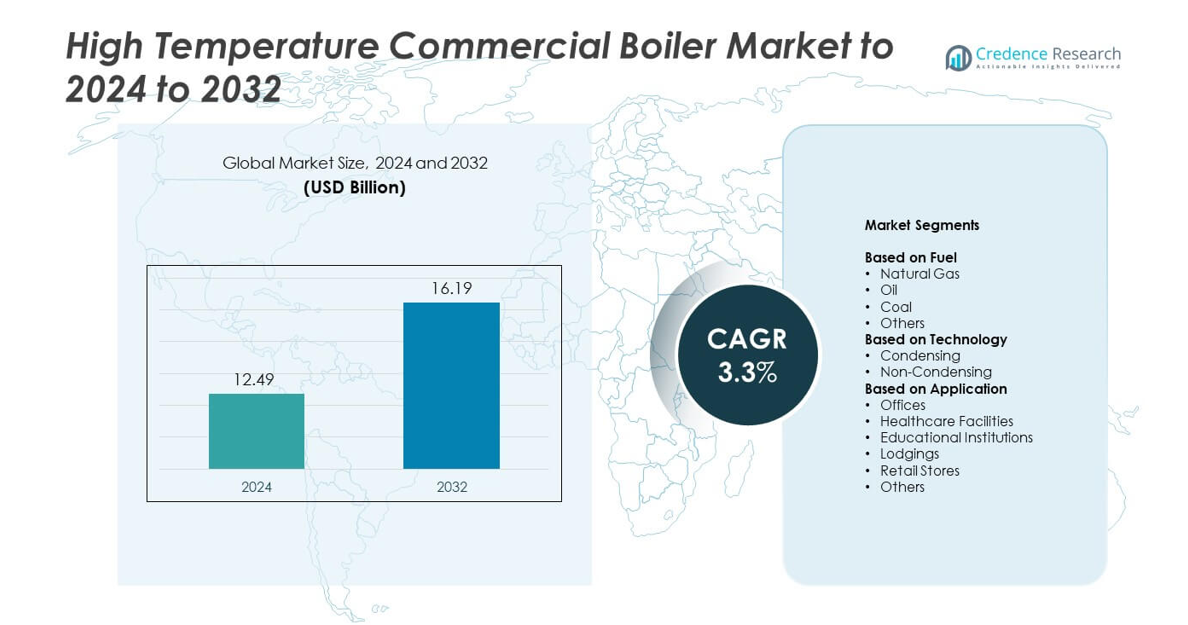1. Introduction
1.1. Report Description
1.2. Purpose of the Report
1.3. USP & Key Offerings
1.4. Key Benefits for Stakeholders
1.5. Target Audience
1.6. Report Scope
1.7. Regional Scope
2. Scope and Methodology
2.1. Objectives of the Study
2.2. Stakeholders
2.3. Data Sources
2.3.1. Primary Sources
2.3.2. Secondary Sources
2.4. Market Estimation
2.4.1. Bottom-Up Approach
2.4.2. Top-Down Approach
2.5. Forecasting Methodology
3. Executive Summary
4. Introduction
4.1. Overview
4.2. Key Industry Trends
5. Global High Temperature Commercial Boiler Market
5.1. Market Overview
5.2. Market Performance
5.3. Impact of COVID-19
5.4. Market Forecast
6. Market Breakup by Fuel
6.1. Natural Gas
6.1.1. Market Trends
6.1.2. Market Forecast
6.1.3. Revenue Share
6.1.4. Revenue Growth Opportunity
6.2. Oil
6.2.1. Market Trends
6.2.2. Market Forecast
6.2.3. Revenue Share
6.2.4. Revenue Growth Opportunity
6.3. Coal
6.3.1. Market Trends
6.3.2. Market Forecast
6.3.3. Revenue Share
6.3.4. Revenue Growth Opportunity
6.4. Others
6.4.1. Market Trends
6.4.2. Market Forecast
6.4.3. Revenue Share
6.4.4. Revenue Growth Opportunity
7. Market Breakup by Technology
7.1. Condensing
7.1.1. Market Trends
7.1.2. Market Forecast
7.1.3. Revenue Share
7.1.4. Revenue Growth Opportunity
7.2. Non-Condensing
7.2.1. Market Trends
7.2.2. Market Forecast
7.2.3. Revenue Share
7.2.4. Revenue Growth Opportunity
8. Market Breakup by Application
8.1. Offices
8.1.1. Market Trends
8.1.2. Market Forecast
8.1.3. Revenue Share
8.1.4. Revenue Growth Opportunity
8.2. Healthcare Facilities
8.2.1. Market Trends
8.2.2. Market Forecast
8.2.3. Revenue Share
8.2.4. Revenue Growth Opportunity
8.3. Educational Institutions
8.3.1. Market Trends
8.3.2. Market Forecast
8.3.3. Revenue Share
8.3.4. Revenue Growth Opportunity
8.4. Lodgings
8.4.1. Market Trends
8.4.2. Market Forecast
8.4.3. Revenue Share
8.4.4. Revenue Growth Opportunity
8.5. Retail Stores
8.5.1. Market Trends
8.5.2. Market Forecast
8.5.3. Revenue Share
8.5.4. Revenue Growth Opportunity
8.6. Others
8.6.1. Market Trends
8.6.2. Market Forecast
8.6.3. Revenue Share
8.6.4. Revenue Growth Opportunity
9. Market Breakup by Region
9.1. North America
9.1.1. United States
9.1.1.1. Market Trends
9.1.1.2. Market Forecast
9.1.2. Canada
9.1.2.1. Market Trends
9.1.2.2. Market Forecast
9.2. Asia-Pacific
9.2.1. China
9.2.2. Japan
9.2.3. India
9.2.4. South Korea
9.2.5. Australia
9.2.6. Indonesia
9.2.7. Others
9.3. Europe
9.3.1. Germany
9.3.2. France
9.3.3. United Kingdom
9.3.4. Italy
9.3.5. Spain
9.3.6. Russia
9.3.7. Others
9.4. Latin America
9.4.1. Brazil
9.4.2. Mexico
9.4.3. Others
9.5. Middle East and Africa
9.5.1. Market Trends
9.5.2. Market Breakup by Country
9.5.3. Market Forecast
10. SWOT Analysis
10.1. Overview
10.2. Strengths
10.3. Weaknesses
10.4. Opportunities
10.5. Threats
11. Value Chain Analysis
12. Porter’s Five Forces Analysis
12.1. Overview
12.2. Bargaining Power of Buyers
12.3. Bargaining Power of Suppliers
12.4. Degree of Competition
12.5. Threat of New Entrants
12.6. Threat of Substitutes
13. Price Analysis
14. Competitive Landscape
14.1. Market Structure
14.2. Key Players
14.3. Profiles of Key Players
14.3.1. Bosch Industriekessel GmbH
14.3.1.1. Company Overview
14.3.1.2. Product Portfolio
14.3.1.3. Financials
14.3.1.4. SWOT Analysis
14.3.2. Cleaver-Brooks
14.3.2.1. Company Overview
14.3.2.2. Product Portfolio
14.3.2.3. Financials
14.3.2.4. SWOT Analysis
14.3.3. Viessmann
14.3.3.1. Company Overview
14.3.3.2. Product Portfolio
14.3.3.3. Financials
14.3.3.4. SWOT Analysis
14.3.4. Hurst Boiler & Welding Co, Inc.
14.3.4.1. Company Overview
14.3.4.2. Product Portfolio
14.3.4.3. Financials
14.3.4.4. SWOT Analysis
14.3.5. Ariston Holding N.V.
14.3.5.1. Company Overview
14.3.5.2. Product Portfolio
14.3.5.3. Financials
14.3.5.4. SWOT Analysis
14.3.6. The Fulton Companies
14.3.6.1. Company Overview
14.3.6.2. Product Portfolio
14.3.6.3. Financials
14.3.6.4. SWOT Analysis
14.3.7. Babcock & Wilcox Enterprises, Inc.
14.3.7.1. Company Overview
14.3.7.2. Product Portfolio
14.3.7.3. Financials
14.3.7.4. SWOT Analysis
14.3.8. AERCO
14.3.8.1. Company Overview
14.3.8.2. Product Portfolio
14.3.8.3. Financials
14.3.8.4. SWOT Analysis
14.3.9. FERROLI S.p.A
14.3.9.1. Company Overview
14.3.9.2. Product Portfolio
14.3.9.3. Financials
14.3.9.4. SWOT Analysis
14.3.10. Columbia Boiler Company
14.3.10.1. Company Overview
14.3.10.2. Product Portfolio
14.3.10.3. Financials
14.3.10.4. SWOT Analysis
14.3.11. PB HEAT, LLC.
14.3.11.1. Company Overview
14.3.11.2. Product Portfolio
14.3.11.3. Financials
14.3.11.4. SWOT Analysis
14.3.12. Miura America Co., LTD.
14.3.12.1. Company Overview
14.3.12.2. Product Portfolio
14.3.12.3. Financials
14.3.12.4. SWOT Analysis
14.3.13. Atlantic Boilers
14.3.13.1. Company Overview
14.3.13.2. Product Portfolio
14.3.13.3. Financials
14.3.13.4. SWOT Analysis
14.3.14. Bradford White Corporation
14.3.14.1. Company Overview
14.3.14.2. Product Portfolio
14.3.14.3. Financials
14.3.14.4. SWOT Analysis
14.3.15. Vaillant Group
14.3.15.1. Company Overview
14.3.15.2. Product Portfolio
14.3.15.3. Financials
14.3.15.4. SWOT Analysis
14.3.16. WOLF
14.3.16.1. Company Overview
14.3.16.2. Product Portfolio
14.3.16.3. Financials
14.3.16.4. SWOT Analysis
14.3.17. Hoval
14.3.17.1. Company Overview
14.3.17.2. Product Portfolio
14.3.17.3. Financials
14.3.17.4. SWOT Analysis
14.3.18. FONDITAL S.p.A.
14.3.18.1. Company Overview
14.3.18.2. Product Portfolio
14.3.18.3. Financials
14.3.18.4. SWOT Analysis
14.3.19. Energy Kinetics
14.3.19.1. Company Overview
14.3.19.2. Product Portfolio
14.3.19.3. Financials
14.3.19.4. SWOT Analysis
14.3.20. BURNHAM COMMERCIAL BOILERS
14.3.20.1. Company Overview
14.3.20.2. Product Portfolio
14.3.20.3. Financials
14.3.20.4. SWOT Analysis
14.3.21. Slant/Fin Corporation
14.3.21.1. Company Overview
14.3.21.2. Product Portfolio
14.3.21.3. Financials
14.3.21.4. SWOT Analysis
14.3.22. Clayton Industries
14.3.22.1. Company Overview
14.3.22.2. Product Portfolio
14.3.22.3. Financials
14.3.22.4. SWOT Analysis
14.3.23. Fonderie Sime S.p.A.
14.3.23.1. Company Overview
14.3.23.2. Product Portfolio
14.3.23.3. Financials
14.3.23.4. SWOT Analysis
14.3.24. Immergas S.p.A
14.3.24.1. Company Overview
14.3.24.2. Product Portfolio
14.3.24.3. Financials
14.3.24.4. SWOT Analysis
14.3.25. Precision Boilers
14.3.25.1. Company Overview
14.3.25.2. Product Portfolio
14.3.25.3. Financials
14.3.25.4. SWOT Analysis
14.3.26. PARKER BOILER
14.3.26.1. Company Overview
14.3.26.2. Product Portfolio
14.3.26.3. Financials
14.3.26.4. SWOT Analysis
14.3.27. Thermal Solutions LLC
14.3.27.1. Company Overview
14.3.27.2. Product Portfolio
14.3.27.3. Financials
14.3.27.4. SWOT Analysis
15. Research Methodology




